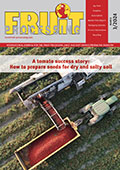Brazil: Low inventories should underpin the demand for juice in 2019/2020
The prices paid to the orange growers from São Paulo and the Triângulo Mineiro region in the 2019/20 season should be positive, despite the larger production, since inventories are forecast to, again, decrease to critical levels at the processors…

The prices paid to the orange growers from São Paulo and the Triângulo Mineiro region in the 2019/20 season should be positive, despite the larger production, since inventories are forecast to, again, decrease to critical levels at the processors from SP State (because of the lower production in 2018/19), underpinning the demand for the fruit.
According to estimates from CitrusBR (Brazilian Association of Citrus Exporters) released in August/18, the ending stocks of Frozen Concentrate Orange Juice (FCOJ) Equivalent forecast to June 30 2019, at 146.7 thousand tons, would only be enough for a two-month exporting period. Therefore, this scenario could underpin orange prices in the Brazilian market in 2019, despite the high production in the 2019/20 season – although positive, the ending stocks in June/18 (related to the 2017/18 crop) were not too large.
Indeed, the first bids from large-sized processors for the oranges from the 2019/20 crop started early again (in October/18). Bidding prices were around 22 BRL per 40.8-kilo box, harvested and delivered at processors (with the possibility of a bonus added to the orange selling price in the international market). In the 2018/29 crop, the first bids were around 20 BRL per box.
Although cautious at first, citrus growers accepted to trade in mid-November, fearing that bidding prices could drop in the following months. Early purchases have been a strategy of large-sized processors since 2016 (when they started closing deals in October, although the 2017/18 crop was one of the largest in all times).
PRODUCTION – Citrus growers believe that the 2019/20 crop will be positive, based on the weather, which favored plants development during blossoming and fruitlet settlement. The main blossoming, which occurred between August and September in most orchards, were large.
In mid-December, the wide temperature range led part of the fruitlets to drop in some regions, mainly in late orange orchards, which are more sensitive to the weather. However, citrus farmers believe these losses should not be significant to the next season results. Still, some growers do not expect a super crop and believe the volume harvested will only recover in 2019/20; others forecast a 40% increase compared to 2018/19.
TAHITI LIME – The tahiti lime volume forecast to be harvested during the crop peak in São Paulo State, in the first quarter of 2019, is also positive. According to Brazilian agents, production may be higher than that from 2018, since the rains in the second semester last year were more frequent and well distributed.
Despite the higher supply, the demand from processors may help to underpin the prices paid to growers, controlling availability in the in natura segment. The good exports performance should also help to underpin tahiti lime quotes, even during the crop peak – shipments may continue at a fast pace, due to the firm demand for the fruit, mainly from Europe, where consumption has been increasing.









